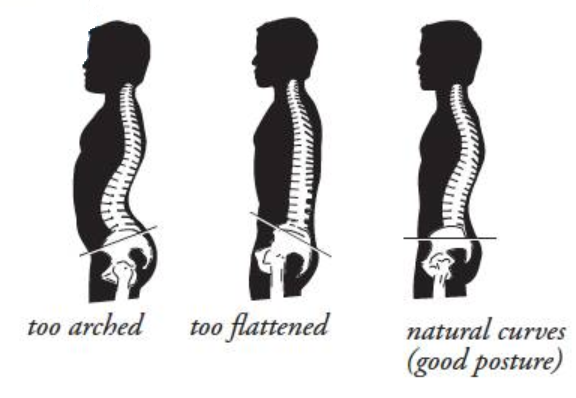Random Training Ramblings: Neutral Spine Concepts
The more I read and learn about anatomy and physiology, the more I begin to learn that there are no hard and fast concepts that stand up with all people at all times, and the more I start to see that what’s commonly used may be less than ideal.
Neutral spine is one of those concepts. At its core, the ideal of neutral spine is a position of neither being in flexion, nor in extension. Essentially, think of a pendulum hanging in balance. It would take an input of energy to move the pendulum in any direction from that dead hang.
So a neutral starting position is classically considered the typical posture we will always see on posture charts, with a normal S shaped curvature of the spine, a mild lumbar lordosis and a mild thoracic kyphosis. Any deviation from this is considered moving away from neutral.
Much of the info we have on the initial use of the term neutral spine comes from Pilates, however from there the definition is somewhat open to interpretation. Some assume it’s where the pelvis is level and under the ears, others assume specific curvature angles of the lumbar and thoracic spine, others assume left to right symmetry, some say whatever posture allows you to stand as tall as possible, and so forth.
Essentially, there isn’t one single posture that can be described as neutral based on conflicting explanations of what neutral spine actually is or involves. This can be problematic when it comes to coaching someone on how to achieve neutral spine when the instructors can’t agree on what it actually is. We all know instinctively when we see someone with a massive scoliotic deviation that they aren’t in a neutral position, but it becomes tougher when it’s closer to the dead hang pendulum position.
There’s a lot of individual variation in structure that can affect where this “neutral” position actually occurs. Whereas one person may have a hip complex that pushes them into more of an anterior tilt from a structural perspective, another may have a spinal abnormality that pushes them into more of a posterior tilt. Then there’s the effect of developmental strain from sport specialization, which can affect the shape and function of bones, and also the aging and degenerative processes, which can also affect structure and function.
However, we know that the spine doesn’t exist in a vacuum, and it’s going to change position with movement. Is the deviation away from “neutral” one that helps the individual excel at their sport, like a sprinter living in anterior tilt and extension, or like a cyclist standing in a massively flexed over position, or is it a response to pain or a driver of dysfunction?
Mike Robertson wrote about this concept a few years ago with THIS AWESOME PIECE, and I agree. For those who don’t have the time to click a link, his belief is that neutral spine is more of an optimal range for a specific exercise or movement versus a static position to adhere to all the time.
This gives a little wiggle room as to what works best for the individual, and based on the activity at hand. For instance, a position for hitting a tackle on the offensive line will likely be more flexed than during a heavy back squat due to the direction of force application. The amount of spine flexion in either of these scenarios will be different from other activities like golf or max deadlifts, so because the spinal position is so very different, using a term like “neutral” doesn’t seem to do anything except explain a position of the spine during passive standing on postural assessments.
The biggest value to postural assessments, at least as far as I’ve found, is that they are fantastic at telling you where movements starting positions are and provide a frame of reference for how far movement actually occurs when you do stuff. For instance, someone with the right shoulder position of the above individual is shrugged and would likely have less of a problem getting to an overhead position with that arm than with the left, as it’s already part of the way there comparatively. I’d be curious to see if this individual could get their left arm over their head, but again, it gives an idea, not a road map. You still have to see how they move rather than just make predictions. This isn’t Tarot card reading.
So let’s say you are actually bent on finding and using neutral spine. Where do you begin? Often, it’s going to be a rough explanation of positioning, as stated earlier. With anatomical differences and potential degenerative changes for anyone over the age of 40, can you actually aptly say what is and isn’t neutral spinal position without the aid of X-ray vision to determine spinal segment angulation? Likely not, but again, it’s probably not that big of a deal.
What I normally will go to is instead of finding a specific position based on alignment, I work with a client to find a position where for the given activity, they feel like they can get the muscles to flex in the desired way, feel strong and stable, and like they’re owning the hell out of the position and movement. For something like a plank, this might mean more of a posterior tilt while not getting too much thoracic rounding. They’re outside of neutral, but the desired benefit of the exercise is being exploited much more than if they were kept in neutral for that position. For a barbell squat, they may be in more posterior tilt.
So should we cue people to be in “neutral” spine? I don’t know. It’s tough to even measure where that is, whether it’s different for the individual at hand, and whether it’s even a beneficial position for the individual to begin in for a specific exercise. There’s always a benefit to return to a lower energetically demanding position during recovery, but that may vary from neutral as well, and being in neutral may not ensure optimal muscle contractions for a specific exercise, so I think following Mike’s example of the range of position that allows the best performance in a specific activity would be considered “neutral.” Even then, this isn’t neutral, just beneficial. You could likely find a dozen other positions to be in to complete the activity, and if you’ve ever worked with adapted physical activity programs or the Paralympics, you’ll see that there’s a massive range of “possible, if not always optimal” for any activity or exercise.






2 Responses to Random Training Ramblings: Neutral Spine Concepts